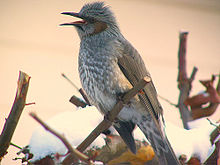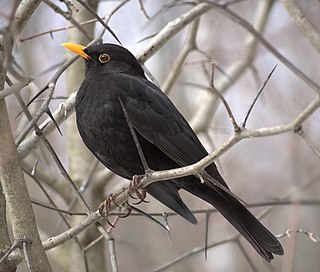
True thrushes are medium-sized mostly insectivorous or omnivorous birds in the genus Turdus of the wider thrush family, Turdidae. The genus name Turdus is Latin for "thrush". The term "thrush" is used for many other birds of the family Turdidae as well as for a number of species belonging to several other families.

The family Cisticolidae is a group of about 160 warblers, small passerine birds found mainly in warmer southern regions of the Old World. They were formerly included within the Old World warbler family Sylviidae.

The greenbuls are a group of birds within the bulbul family Pycnonotidae, found only within Africa. They are all largely drab olive-green above, and paler below, with few distinguishing features.

The tetrakas and allies are a newly validated family of songbirds. They were formally named Bernieridae in 2010. The family currently consists of eleven species of small forest birds. These birds are all endemic to Madagascar.

Arizelocichla is a genus of greenbuls, songbirds in the bulbul family (Pycnonotidae). The genus was revived in 2010 when twelve species of bulbuls from the genus Andropadus were separated and re-classified in the genus Arizelocichla.

The slender-billed greenbul is a species in the monotypic genus Stelgidillas of the bulbul family of passerine birds. It is found in western and central Africa. Its natural habitats are subtropical or tropical dry forest, subtropical or tropical moist lowland forest, and subtropical or tropical moist montane forest.

Falkenstein's greenbul is a species of songbird in the bulbul family, Pycnonotidae. It is found from western Cameroon and Central African Republic to central Angola. Its natural habitats are subtropical or tropical moist lowland forests, moist savanna, and subtropical or tropical moist shrubland.

The yellow-throated leaflove is a species of leaflove in the bulbul family of passerine birds. It is the only species of the monotypic genus Atimastillas. The yellow-throated leaflove is found in western and central Africa. Its natural habitats are subtropical or tropical dry forests, moist savanna, and subtropical or tropical moist shrubland.

The western bearded greenbul is a species of songbird in the bulbul family, Pycnonotidae. It is found in West Africa. Its natural habitats are subtropical or tropical dry forests and subtropical or tropical moist lowland forests.

Criniger is a genus of songbirds in the bulbul family, Pycnonotidae. The species of Criniger are found in western and central Africa.

Hemixos is a songbird genus in the bulbul family, Pycnonotidae.

Hypsipetes is a genus of bulbuls, songbirds in the family Pycnonotidae. Most of its species occur in tropical forests around the Indian Ocean. But while the genus is quite diverse in the Madagascar region at the western end of its range it does not reach the African mainland.
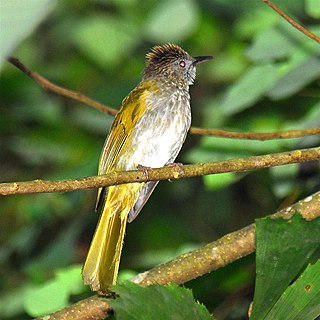
Ixos is a genus of passerine birds in the bulbul family, Pycnonotidae.

The sulphur-bellied bulbul is a songbird species in the bulbul family, Pycnonotidae. It is endemic to Palawan (Philippines). Its natural habitat is subtropical or tropical moist lowland forests. It is not considered a threatened species by the IUCN.

The Philippine bulbul is a songbird species in the bulbul family, Pycnonotidae.
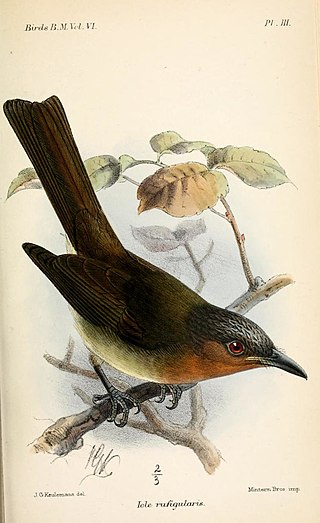
The Zamboanga bulbul is a songbird species in the bulbul family, Pycnonotidae. It is endemic to the Philippines, where its natural habitat is subtropical or tropical moist lowland forests of Basilan and the Zamboanga Peninsula. It is becoming rare due to habitat loss.

The streak-breasted bulbul is a songbird species in the bulbul family, Pycnonotidae.
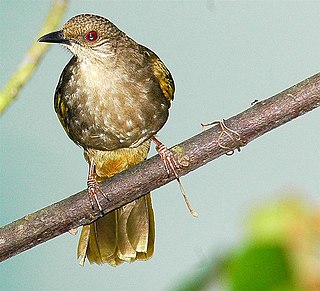
Pycnonotus is a genus of frugivorous passerine birds in the bulbul family Pycnonotidae.

Iole is a genus of songbirds in the bulbul family, Pycnonotidae. They are native to tropical eastern Asia, from India to China and south through Southeast Asia to northern Indonesia.

Eurillas is a genus of greenbuls, passerine birds in the bulbul family Pycnonotidae.
